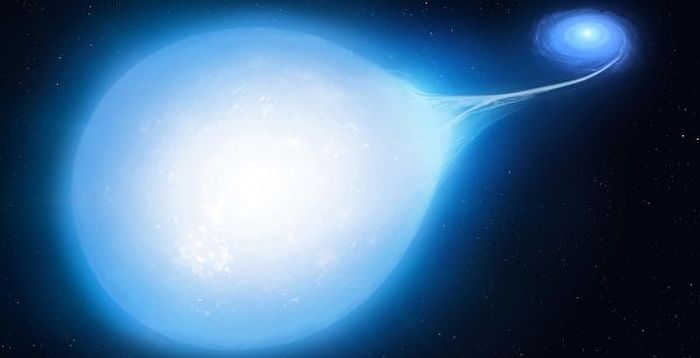[The Epoch Times, October 7, 2022](The Epoch Times reporter Takasugi compiles a report) In our galaxy, unlike the lone sun, about half of the stars maintain a long-term, “celestial marriage” with another star. “, orbiting each other in a so-called “binary star system”.
This week, researchers described a failed “celestial marriage” between one of the near-extreme binary “partners”, Nationalpost reported. The pair of stars orbit each other every 51 minutes. Its orbital period is the rarest and fastest of any known binary star class. In this “celestial marriage breakdown” plot, a star is slowly eating its older partner.
The two stars are located in a region about 3,000 light-years from Earth in the direction of the constellation Hercules. A light-year is the distance light travels in one year, or 5.9 trillion miles (9.5 trillion kilometers).
The system belongs to a class of binaries known as “Cataclysmic Variables,” in which a sun-like star orbits near a so-called white dwarf, which is basically a hot, dense star of a burned-out star core. The so-called variable stars refer to the changes in their combined brightness over time when viewed from Earth. The “catastrophic” refers to the change in brightness that is very large, in some cases, 10,000 times or more than normal.
Over millions of years, the distance between the two stars has now shrunk to be closer than the moon is to Earth.
Kevin Burdge, an astrophysicist at the Massachusetts Institute of Technology (MIT), explained: “Imagine if the moon were zipping across the sky 10 times a night. That’s the kind of speed we’re talking about.” He is the lead author of the study published this week in the journal Nature.
Just because they’re close to each other doesn’t mean they’re good to each other, though — the white dwarf is ruthlessly consuming its body from its partner.
That larger star is about the same temperature as the Sun, but has been stripped down to only about 10 percent of the Sun’s diameter. That makes it already about the size of Jupiter, the largest planet in our solar system. The white dwarf is about 1.5 times the diameter of Earth, but is very dense, with about 56% the mass of the Sun.
“It’s a pair of old stars that have been together for a long time,” Birch said. “When the stars get old and die, they both become white dwarfs. But now one of the lingering stars is moving, and it’s eating its companions.” ”
“Basically, they’ve been together in a binary orbit for 8 billion years,” Birch said. “And now, just before the second star can end its stellar life cycle and become a white dwarf in the usual way stars do — By evolving into a type of star called a red giant—the remaining white dwarf remnant of the first star—interrupting the companion’s end-of-life and transition process, it began to slowly devour it.”
The researchers used data from the Palomar Observatory in California and telescopes in Hawaii and the Canary Islands.
Most stars are composed mostly of hydrogen, with small amounts of helium and other elements. The larger of the binary — the “older” one — is unusually rich in helium. This is not only because its companions have eaten its outer layers of hydrogen, but also because it slowly fuses hydrogen atoms into helium in a thermonuclear furnace, where there is an abundance of helium in its core.
The binary system brightens and dims periodically, in part because the larger star is physically deformed into a water droplet instead of its original spherical shape, pulled by the white dwarf’s gravitational pull.
“There’s a lot of crazy stuff going on in space right now,” Birch said.
Responsible editor: Ye Ziwei#
